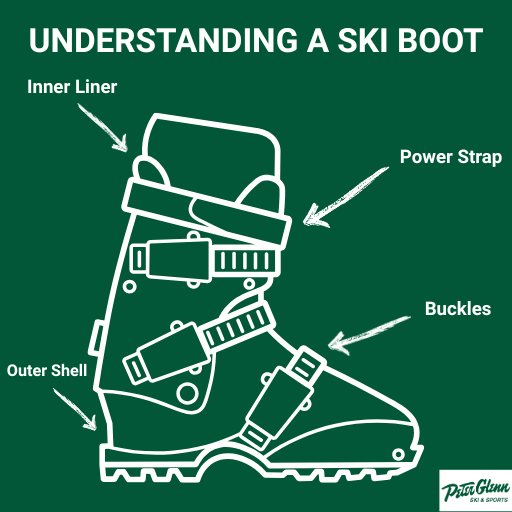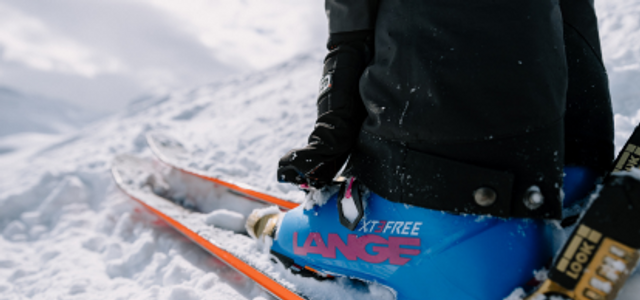Finding the Best Ski Boots: What Every Skier Should Know
Posted by Peter Glenn Staff on Sep 22nd 2025
Table of Contents:
The Short Answer: Ski boots are the most important piece of ski equipment you'll buy, serving as the direct connection between you and your skis. A well-fitted boot provides precise control, comfort, and power transfer while skiing, making proper boot selection and fitting absolutely necessary for an enjoyable skiing experience on the slopes.
Your comfortable ski boot can make or break your time on the mountain. These specialized boots do far more than just keep your feet warm - they transfer every movement of your legs directly to your skis, allowing you to control your direction and speed with precision. The right boot combines a perfect fit with the correct boot flex for your skiing ability, ensuring you can progress confidently on the slopes.
Understanding Ski Boot Fit and Sizing

Unlike regular shoe sizing, ski boots use a specialized measurement system called Mondo Point sizing, which measures your foot length in centimeters. A size 26.5 Mondo equals approximately a men's US size 8.5, offering more precise fitting than traditional shoe sizes.
The right boot fit involves two main components: the rigid outer shell and the ski boot liners. The shell provides the foundation of your boot's downhill performance, while the heat-moldable liners mold to your foot shape over time. When trying on new ski boots, remove the liner and place your foot in the shell – you should have about 1-1.5 cm of space behind your heel when your toes touch the front.
For skiers with medium-width feet, the Nordica Speedmachine 3 120 BOA DD Ski Boot is a solid option. It combines a heat-moldable liner with BOA adjustability to fine-tune the fit around the instep and ankle.
Flex Ratings and Ski Boot Skill Levels
Ski boot flex ratings are numbered measurements that indicate how much resistance a boot provides when flexing forward. Understanding these boot flex ratings helps match your ski boots to your skiing experience and physical characteristics.
Beginner Flex (60-80)
Softer flex ratings allow for more forgiveness and easier movement, making them perfect for those learning proper technique. These comfortable boots flex readily, making it simpler to initiate turns and maintain control at slower speeds. Beginners benefit from this gentler response as they build confidence on the slopes.
A good starter option is the Nordica Sportmachine 3 75 Ski Boot. With a soft flex and roomy fit, it’s perfect for newer skiers who want all-day comfort while learning the basics.
Intermediate Flex (85-100)
As skills progress, a stiffer boot provides better power transfer and responsiveness. This mid-range progressive flex balances comfort with downhill performance, offering enough support for faster speeds while maintaining some forgiveness. The stiffer construction helps intermediate skiers drive their skis more effectively through varied terrain.
The Atomic Hawx Prime 85 BOA GW Ski Boot gives growing skiers a supportive 85 flex with the BOA Fit System for quick, glove-friendly adjustments.
For men, the Nordica Sportmachine 3 110 BOA Ski Boot offers a balance of comfort and control for intermediates who ski a mix of groomers and all-mountain terrain.
Advanced/Expert Flex (110-130+)
High-performance boot models feature the stiffest flex ratings for maximum power transmission and precise control. These stiff boots require more strength and technique to flex properly but reward expert skiers with superior edge control and stability at high speeds. The rigid construction delivers instant response for aggressive skiing.
The Atomic HX Ultra 95 BOA GW Ski Boot offers a narrower fit and strong performance on steep, technical runs.
Men can look to the Salomon S/Pro Dual BOA 120 Ski Boot for a race-level response with dual BOA dials to secure both the lower and upper shell.
Boot Construction and Features

Modern ski boots blend sophisticated engineering with advanced materials to deliver optimal downhill performance on the slopes. The boot shell construction typically uses polyurethane or polyether materials, with high-performance boots featuring bi-injection molding that combines rigid and softer plastics for progressive flex patterns. These materials provide the perfect fit and power transmission.
Liner Technology
Ski boot liners come standard in most boots, offering basic cushioning and insulation. Heat-moldable liners take comfort to the next level, using body heat or artificial heating to conform to your foot shape. Custom footbed liners represent the premium option, where specialized foam is injected around your foot to create a comfortable boot fit.
The Lange Shadow 85 LV GW Ski Boot features a low-volume fit and premium liner construction for skiers who demand maximum edge control with an approachable flex.
For men, the Lange Shadow 120 LV GW Ski Boot delivers the same locked-in performance with minimal foot movement.
Closure Systems and Adjustability
The boot's buckle system is your main interface for fine-tuning fit and performance. Most boots feature micro-adjustable aluminum buckles, with higher-end models offering tool-free adjustment and memory positions. Modern ski boots incorporate walk mode with specialized gripwalk soles, letting you switch between skiing and walking configurations without compromising performance.
The Dalbello Veloce Space 120 Dual BOA Ski Boot uses dual BOA dials to independently adjust forefoot and cuff tension, giving skiers fine-tuned control.
Women can opt for the Dalbello Veloce Space 95 BOA Ski Boot, which blends comfort with a responsive flex for all-mountain versatility.
Making a Decision
Getting the right ski boot is all about making informed choices and working with expert boot fitters who understand both the technical aspects and your specific needs. At Peter Glenn, you'll find a curated selection of best ski boot brands across different price points. This range accommodates everyone from casual skiers to dedicated expert skiers.
The Break-in Process
Your new ski boots will need about 3-5 full skiing days to break in properly. During this period, wear them around the house for 15-20 minutes at a time to help mold the ski boot liners to your foot shape.
If you’re seeking a forgiving women’s boot that will break in quickly, consider the Nordica Speedmachine 3 BOA 85 W Ski Boot. It offers a comfortable fit that gets even better with time.
Get Your Next Pair of Ski Boots at Peter Glenn
Finding your perfect ski boot is a blend of understanding boot flex, fit characteristics, and your skiing experience. Remember that proper sizing and foot shape are non-negotiable factors for both comfort and downhill performance. To maintain your ski boots, always secure the power strap and buckles when not in use, dry the ski boot liners after each use, and store them in a cool, dry place during off-season.
Ready to step into comfort and performance? Stop by Peter Glenn today for a boot fitting session to find your ideal ski boot purchase. Your perfect powder days start with perfectly fitted boots.



